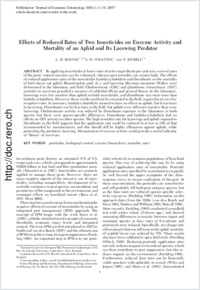Effects of reduced rates of two insecticides on enzyme activity and mortality of an aphid and its lacewing predator
- Booth, L. H. National Centre for Advanced Bio-Protection Technologies, Lincoln University, Canterbury, New Zealand - Landcare Research, Lincoln 8152, Canterbury, New Zealand
- Wratten, S. D. National Centre for Advanced Bio-Protection Technologies, Lincoln University, Canterbury, New Zealand
- Kehrli, Patrik National Centre for Advanced Bio-Protection Technologies, Lincoln University, Canterbury, New Zealand - Unit of Ecology and Evolution, Department of Biology, University of Fribourg, Switzerland
-
2007
Published in:
- Journal of Economic Entomology. - 2007, vol. 100, no. 1, p. 11-19
English
By applying insecticides at lower rates of active ingredients per unit area, survival rates of the pests' natural enemies can be enhanced, whereas pest mortality can remain high. The effects of reduced application rates of the insecticides lambda- cyhalothrin and dimethoate on the mortality of bird cherry-oat aphid, Rhopalosiphon padi (L.), and lacewing Micromus tasmaniae Walker were determined in the laboratory and field. Cholinesterase (ChE) and glutathione S-transferase (GST) activities in survivors provided a measure of sublethal effects and general fitness. In the laboratory, lacewings were less sensitive than aphids to both insecticides, and dimethoate was more toxic than lambda-cyhalothrin. However, these results could not be recreated in the field, in part due to very low recapture rates. In summary, lambda- cyhalothrin seemed to have no effect on aphids, but it was toxic to lacewings. Dimethoate was far less toxic in the field, but aphids were still more sensitive than were lacewings. Cholinesterase activity was reduced by dimethoate exposure in the laboratory in both species, but there were species-specific differences. Dimethoate and lambda-cyhalothrin had no effects on GST activity in either species. The high mortality rate for lacewings and aphids exposed to dimethoate in the field suggests that the application rate could be reduced to as low as 10% of that recommended by manufacturers, and this should still be highly efficacious against aphids, while protecting the predatory lacewing. Measurement of enzyme activity could provide a useful indicator of "fitness" of survivors.
- Faculty
- Faculté des sciences et de médecine
- Department
- Département de Biologie
- Language
-
- English
- Classification
- Biological sciences
- License
- License undefined
- Identifiers
-
- RERO DOC 6590
- DOI 10.1093/jee/100.1.11
- Persistent URL
- https://folia.unifr.ch/unifr/documents/300169
Statistics
Document views: 134
File downloads:
- kehrli_err.pdf: 209
